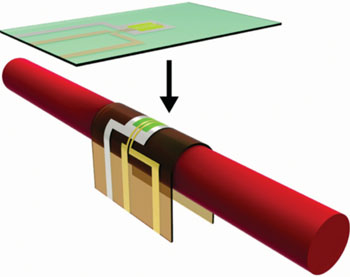Adaptive Organic Transistors Transform Implantable Electronics
By HospiMedica International staff writers
Posted on 05 Jun 2014
Innovative electronic devices based on shape-memory polymers can deploy when implanted inside the body to grip anatomic structures such as nerves and blood vessels.Posted on 05 Jun 2014
Developed by researchers at the University of Texas (Dallas, USA) and the University of Tokyo (Japan), the biologically adaptive, flexible organic thin-film transistors (OTFTs) are bonded to the shape-memory polymers, which respond to the body’s heat environment and become less rigid once they are implanted. By doing so, the OTFTs can be adapted to be closer in size and stiffness to biologic structures, thus making them much more biocompatible than current rigid plastic sensors that stays the same shape and stiffness throughout their lifetime.

Image: OTFTs bonded to shape-memory polymers change shape when heated (Photo courtesy of UT Dallas).
During testing, the researchers used heat to deploy the device around a cylinder as small as 2.25 millimeters in diameter, and implanted the device in rats. They found that after implantation, the device had morphed with the living tissue while maintaining excellent electronic properties. The next step of the research is to shrink the devices so they can wrap around smaller objects and add more sensory components, so that they might one day help doctors learn more about what is happening inside the body, as well as stimulate the body for treatments. The study was published in the May 2014 issue of Advanced Materials.
“Scientists and physicians have been trying to put electronics in the body for a while now, but one of the problems is that the stiffness of common electronics is not compatible with biological tissue,” said lead author Jonathan Reeder, BSc, a graduate student in the UT Dallas department of materials science and engineering. “You need the device to be stiff at room temperature so the surgeon can implant the device, but soft and flexible enough to wrap around 3-D objects so the body can behave exactly as it would without the device. By putting electronics on shape-changing and softening polymers, we can do just that.”
Related Links:
University of Texas
University of Tokyo














